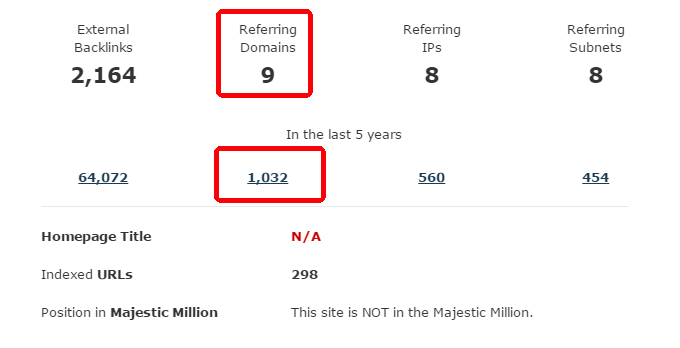Back in 2014, I had the opportunity to help over 20 larger websites and systems to shake off the filters and penalties imposed by Google. That knowledge base has allowed me to draft a shortlist of things to watch out for and how to make the best use of Majestic as an early warning system for an imminent penalty:
– Anchor Text Report
Expect trouble if in the Anchor Text Report, in the top places with several referring domains, you can see many links with an exact match anchor. Opinions are as varied as the number of SEO experts, but it is safe to have only a small percentage of such links which shouldn’t stand out too much in the report.
– Historical Report

Imagine you start search engine optimisation of a “new domain” and the client claims that he has never done any SEO? It’s worth checking this out, as these type of reports are very popular in Poland. Unfortunately, that is normally the situation when the last company only ever used automatic link exchanges for SEO. SEO of a domain like this can lead to serious problems in the future. All of this should be taken into account when budgeting for a project.
– Do you manage hundreds of domains or do you have a monitoring tool?
Majestic provides you with easy API which lets you check the basic parameters. It is worth constantly monitoring incoming links and having alerts for situations when the number of referring domains increases dramatically. If you don’t need an entire system, I would recommend regularly checking the number of links using Bulk Backlinks: https://pl.majestic.com/reports/bulk-backlink-checker, which allows you to check large numbers of domains at the same time.
– Blasted by malicious competition?
It is worth monitoring, at least once a month, the links growth chart. It’s a simple visual report which can indicate that you suddenly have a bigger problem with incoming links, and tell you if the commissioned link building work was spread over time or carried out in one day.
– Analysis of the types of links
I can also recommend a simple analysis of how the links are divided via the prism of domain country codes. I work in many markets where typically malicious links come with an “RU” extension. On those occasions, I export domains from the ref domain report and analyse the percentage per country of origin using simple rules in Excel/Open Office Calc.
– Links to subpages
It is very easy to see if a specific subpage has received a large number of primarily automatic links. In my experience, in the majority of cases a profile has a link created in our service/forum for the benefit of ranking another website (pyramid). The other option is SEO-PR, that is, another company linking to your website because it wants your results to be very high due to certain content on your website. In most cases they do it without consulting you and with little consideration for the risk posed by the automatic links they create.
There are, of course, advanced tools for cleaning link profiles and specialist companies which offer such services. Since prevention is better than cure, I would, however, recommend checking the relevant reports in Majestic on a regular basis because it is much better to do that than to try to save a link profile after being penalised by Google.
- Five of the most awkward questions asked by SEO clients - April 28, 2016
- Can you use Social Media traffic to generate more links to your content? - February 16, 2016
- Catch these ‘must have’ links with Majestic - December 1, 2015







What would be cool is that Majestic could analyze all the signals of spam backlinks and give us a spam report like Moz
April 2, 2015 at 1:54 pm>>like Moz<<
You mean like Moz launched last week?
Although our approach is very different, there is already a wealth of data that we can offer around low quality. Here are a few posts that may help:
https://blog.majestic.com/research/identifying-a-bad-backlink-profile/
https://blog.majestic.com/training/unnatural-links-investigations/
https://blog.majestic.com/general/case-study-how-to-remove-a-google-penalty-with-majestic-seo/
Because we have two metrics, Citation flow and Trust Flow, the difference between these is a good way to understand low quality pages using Majestic. Low Trust and High citation = red flag. One advantage we have is that we calculate these metrics (daily) at the URL, subdomain and domain level. This makes the data universal. We do not, however, look at on page signals like the new Moz signal does, so I am told. I think the approaches are very different and both are helpful.
April 7, 2015 at 8:12 pm